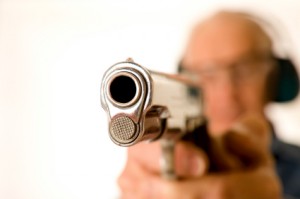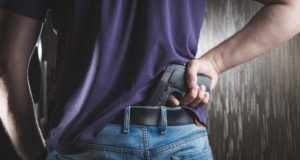When you’ve finally decided on a defensive handgun, there are a few things you can do to ensure you are getting the most out of it as a defensive tool. The following five ideas will help to improve your familiarity with your gun and give you a peace of mind and a level of experience that is hard to obtain any other way.
Dry Firing
 This one is on every forum and is talked about on the first day of training in just about any concealed carry course or defensive handgun training session. The reason is that it’s incredibly effective when used properly. The goal here is to not take it for granted. Sure you can improve a trigger a bit by dry firing (in many cases), but the real benefit is the focus on using the weapon with your own hand, becoming more familiar with the timing of things during firing and the feel of the weapon during action. If you were to stand and dry fire, you could simultaneously work on muscle control, shooting position, orientation, and sight picture enhancements as well. If you simply sit on the couch and pull the trigger, you’ll only get good at pulling the trigger lazily. Be engaged in the process of using the firearm to come from “ready” to “firing.” Practice quickly and effectively clearing the chamber with a variety of hand positions and loading the chamber with a full racking of the slide, like the operatives in Israeli Intelligence operations do. This will help you become more capable with your gun. It will eventually become second nature to observe and react to malfunctions or situational specifics regarding your gun. Dry firing is an effective procedure to help you come on target and be ready to fire and to dispatch a threat.
This one is on every forum and is talked about on the first day of training in just about any concealed carry course or defensive handgun training session. The reason is that it’s incredibly effective when used properly. The goal here is to not take it for granted. Sure you can improve a trigger a bit by dry firing (in many cases), but the real benefit is the focus on using the weapon with your own hand, becoming more familiar with the timing of things during firing and the feel of the weapon during action. If you were to stand and dry fire, you could simultaneously work on muscle control, shooting position, orientation, and sight picture enhancements as well. If you simply sit on the couch and pull the trigger, you’ll only get good at pulling the trigger lazily. Be engaged in the process of using the firearm to come from “ready” to “firing.” Practice quickly and effectively clearing the chamber with a variety of hand positions and loading the chamber with a full racking of the slide, like the operatives in Israeli Intelligence operations do. This will help you become more capable with your gun. It will eventually become second nature to observe and react to malfunctions or situational specifics regarding your gun. Dry firing is an effective procedure to help you come on target and be ready to fire and to dispatch a threat.
Snap Caps
These little items will help you in performing chamber-clearing exercises that can help you to become a better shooter defensively. They also protect the firing pin and breech face in extended dry firing training. The force of the firing pin/striker strike will be transferred to the snap cap and not to the breech face or the shoulder of the firing pin/striker. The snap cap can be used as a dummy round to help with manual interaction with your handgun, as well as serve as a longevity tool. It is important to note, however, that dry firing and dummy rounds/snap caps are ineffective for predicting full functionally of a firearm.
Laser Training
There are recent developments in the market with many ranges offering interactive shooting sessions with lasers or “simunition,” and in some cases even live ammunition with hit zone projection screens. The situations portrayed on the screen are more realistic than most other training conditions and offer a real-time feedback in many cases. Just recently as well, there have been developments in the dual laser market with offers of a target acquisition AND a target strike marking laser to determine where you have actually placed the shot in training. These tools can be incredibly useful in improving shooting skills and situational awareness. Most importantly, the feedback you receive is much more useful in improving your mindset and helping to break old habits as you can see the reality of your shooting/sighting techniques. Simunitions are not readily available on the civilian markets, so, despite being useful for training, they aren’t practical for most, not to mention they are expensive. Paintball and other training techniques are woefully inadequate, as they don’t provide reality-based platforms (they don’t use your duty weapon and they can decrease your fear level or adrenaline response by conditioning you to being shot, rather than avoiding being shot). Ideally, you would consider real-time training techniques to improve your shots on target and the holstering/de-holstering as well as sight acquisition and action on target.
Keep Your Handgun Locked and Loaded, Ready For Instant Use – Without Fear Of An Accident!
Rotating Mags and Mag Springs
Rotating magazine springs in guns where you stay loaded full time is important. Most concealed-carry weapons holders shoot at least every two months with the two or three magazines they carry to keep the ammunition and springs fresh (see below). Specifically, fully loaded magazines will become weak if they remain constantly loaded. The magazines will need to be rotated or the springs will need to be swapped in and out to maintain proper tension and feeding capability. There are generally two ways to achieve this:
- Buy several magazines, and each time you shoot (at least once every two months, and hopefully more often than that), fill the magazines that were NOT used with the next set of cartridges to put the magazines you DID use out of commission for a while, until you shoot again. This will allow the springs and feed lips to have less stress put on them.
- Buy extra magazine springs and replace the springs each time you load a new magazine full of cartridges. This way, the springs can be “unsprung” properly for a period of time that rotates, allowing them a much longer life cycle.
NOT Rotating Ammunition
New ammunition that is free of cycling marks, nicks, and dents will be the most effective self-defense round. You should ideally avoid taking ammunition out of the magazines in any way once you put it in. The feed lips are incredibly rough on the rim of the cartridges in many cases and can cause malfunctions in the firearm during the most important time (in a self-defense situation). If you must remove the ammunition, do so carefully and reload VERY carefully to avoid striations, dents, nicks, and scratches, which can lead to decreased functionality. The best option is to shoot the rounds and then load new ammo in its place.
Using these methods can help present a more perfect scenario for you in the case of a defensive situation with your handgun. Knowing your weapon and constantly testing your capabilities as well as keeping things in good working order will give you a distinct advantage in a defensive scenario.
©2012 Off the Grid News
 Off The Grid News Better Ideas For Off The Grid Living
Off The Grid News Better Ideas For Off The Grid Living




